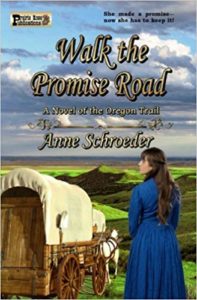I could feel the dust and grime of the trail when I read Anne Schroeder’s Walk the Promise Road: A Novel of the Oregon Trail.
When Mary Rodgers’mother, father and little brother die from an influenza epidemic, she’s not only heartbroken, she’s alone in the world. She does have her cousin Philip, but he’s soon to leave Illinois to join his fiancé in Oregon. Mary, not quite eighteen, is determined to have a life, not be married off to someone she doen’t even love. She convinces her cousin that she could join him, that they could travel as a married couple. After all, they have the same last name. There would be no way a wagon train would take a young woman without a husband–it would be unseemly, and could cause trouble among the single men. Philip, not much older than Mary, could not be considered a proper escort. Philip resists, but Mary convinces him that it would not only work, but that she would be an asset on the trip, a helpmate.
It’s April, 1848 when they meet their travel companions in Independence, Missouri. The wagonmaster and Lucas Sayer, his half-Indian trail scout, assemble the 117 people and their 61 wagons and set out for the 2,000-mile journey. Mary and Philip’s secret seems to work, and they are known as “the Rodgers” and assumed to be husband and wife.
When Lucas begins spending time at the Rogers’ fireside, Mary struggles to keep their secret. Lucas is the most desirable man she’s ever known, and it’s obvious that he feels the same about her. Other travelers notice and tongues begin to wag.
I particularly appreciated Anne Schroeder’s realistic description of the hard journey west. I’ve always loved stories about the Oregon Trail and this novel is exceptional in its authenticity. It’s amazing that the west was ever settled. Emigrants constantly struggled to move forward, bone-tired and thirsty. Wagons broke down, stock died from exhaustion, people died of disease or lack of desire to struggle on. There were always those who prepared, like Philip, and those who did not and ultimately had to depended on others. For women and many of the older children, the journey was made mostly on foot, doing everything they could to lighten the load for the mules, horses or oxen that pulled the heavy wagons. There was either not enough water, or too much water. Heartbroken women left their treasures along the trail in order to lighten the load so the beasts wouldn’t die in their traces. Travelers bickered, some went their own way, often with disastrous results. It was a long, grueling journey and the lucky ones arrived in Oregon six long months later.
Walk the Promise Road is a journey to remember.



I read Anne’s book and absolutely loved it!! Her research shines in this novel and her characters are so realistic. A job well done!
Thank you, Mary for a thorough and insightful review. You have an ability to see and appreciate the author’s intention. Thank you for this.
You’re welcome, Anne. It was a pleasure reading this book. You did an excellent job showing what life was like on the Oregon Trail.